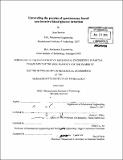Unraveling the puzzles of spectroscopy-based non-invasive blood glucose detection
Author(s)
Barman, Ishan
DownloadFull printable version (21.22Mb)
Other Contributors
Massachusetts Institute of Technology. Dept. of Mechanical Engineering.
Advisor
Robert J. Silbey.
Terms of use
Metadata
Show full item recordAbstract
Disorders of glucose homeostasis, including types 1 and 2 diabetes, represent a leading cause of morbidity and mortality worldwide. Diagnosis and therapeutic monitoring of diabetes requires direct measurement of blood glucose. Regardless of the clinical test performed, however, withdrawal of blood is currently required for measurement of blood glucose levels. Non-invasive measurement of blood glucose levels is highly desired, given the large number of diabetics who must undergo glucose testing several times each day. In this context, near-infrared (NIR) Raman spectroscopy has shown substantial promise by providing successful predictions of glucose at physiologically relevant concentrations in vitro and even in individual human volunteers at single sittings. Nevertheless, prospective application of a spectroscopic calibration model - over a larger population or over several sittings - has proven to be challenging. This thesis investigates the optical and physiological challenges that impede calibration transfer by introducing non-analyte specific variances. Specifically, we present major advances in four research directions. First, the effects of sample-to-sample turbidity induced variations in quantitative spectroscopy are studied. To account for these variations, a novel method, based on the photon migration theory, is proposed. We demonstrate that the proposed method can extract intrinsic line shapes and intensity information from Raman spectra acquired in a turbid medium thereby improving quantitative predictions significantly. Second, we quantify the sensitivity of Raman calibration models to endogenous fluorescence and its temporal quenching. Application of shifted subtracted Raman spectroscopy is proposed to reduce the possibility of spurious models developed on the basis of chance correlation between the concentration dataset and quenched fluorescence levels. Third, we solve the problem of physiological lag between blood and interstitial fluid glucose levels, which creates inconsistencies in calibration, where blood glucose measurements are used as reference but the acquired spectra are indicative of ISF glucose levels. To overcome this problem, we introduce a mass transfer-based concentration correction scheme and demonstrate its effectiveness in clinical studies. Finally, we propose a new design for fabricating a handheld Raman glucose monitor by employing excitation and detection of wavelengths selected on the basis of their spectral information content. Based on the advances in instrumentation and methodology outlined in this thesis, we anticipate that our current clinical studies will establish the viability of Raman spectroscopy for non-invasive blood glucose detection.
Description
Thesis (Ph. D.)--Massachusetts Institute of Technology, Dept. of Mechanical Engineering, 2011. Cataloged from PDF version of thesis. Includes bibliographical references.
Date issued
2011Department
Massachusetts Institute of Technology. Department of Mechanical EngineeringPublisher
Massachusetts Institute of Technology
Keywords
Mechanical Engineering.